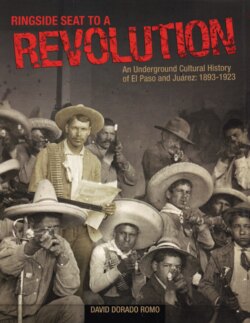Читать книгу Ringside Seat to a Revolution - David Dorado Romo - Страница 30
На сайте Литреса книга снята с продажи.
ОглавлениеA large portion of the first El Paso Times article, written
about Teresita four days after her arrival, was dedicat-
ed to her looks:
The saintess can hardly be called beautiful,
notwithstanding the infatuation of the [El
Paso] Times reporter for this Mexican god-
dess. But then she is “interesting,” even if
she is thinner ‘n a bed slat, and wears a
philosophical air, has bright lustrous eyes,
and in more ways than one suggests the
Boston girl, the habitué of the Concord
school of philosophy. And when she substi-
tutes a black silk dress and seville lace for
that yellow, blue black polka-dotted gown,
she looks quite recherché. If now she could
only be sent off for a couple of years to one
of the east Texas seminaries for young ladies
and be taught how to flash a new dress on
an unsuspecting public every week, play
progressive euchre, learn enough French to
appear as an elegant passé dilettante in
upper swelldom...Mademoiselle Santa Teresa
Urrea would become even more of a shining
success than she is now.27
Besides this backhanded compliment, the article
had very little good to say about Teresita. The El Paso
Times acknowledged that Teresita did not accept
money for healing the sick, but it accused Lauro Aguirre
and the Independiente staff of exploiting Teresita to
help them “raise funds from the credulous with which
to boom their paper much after the fashion of the
Ephesian gentlemen in the scriptures, who used a half-
witted girl as a soothsayer to enrich themselves.”28
The morning newspaper grumbled about the
kind of crowd that Santa Teresa was attracting to the
Anglo section of town. Teresa’s Mexican devotees
were a real “nuisance,” the El Paso Times complained:
The “saintess” quarters on South Campbell
Street are getting to resemble the surround-
ings of a Russian free barbecue. Mexicans of
all degrees of rags and tatters, and almost no
rags or tatters at all, load up the waiting
room, jam the porch, squat around in the
yard on the adjacent sidewalk, block the
sidewalks in front of the county jail and
make nuisances of themselves generally. The
immediate vicinity of the saintess headquar-
ters does not smell over-nice: but then there
is no water in the acequia for the Aztec hosts
to bathe in. So over-nice discriminations are
hardly called for.29
The El Paso Times, fearing that more “Indians”
were on their way to El Paso to visit Teresita, called
for her “to move over to the south side of the ace-
quia,” and take with her “the peons and pelados who
are thronging up onto South Campbell Street.” A
week after this article appeared, the city shut off the
water in Aguirre’s yard. Teresita and her family decid-
ed to move to the Second Ward—the Mexican section
of town also known as Segundo Barrio. Their new
abode was an adobe building on 500 South Oregon
Street which had once served as the old customhouse
and later as the Ladies’ Hospital.
But not all Anglos agreed with the El Paso Times’
delicate nose. The El Paso Chamber of Commerce
realized that the crowds Teresita brought to town
were good for business. They donated a large tent for
the comfort of her visitors and placed it opposite
Teresita’s home.
A party of prominent El Pasoans visited the young
miracle worker to discuss her healing powers. The
group included Judge Kemp, City Attorney Townsend,
his wife, and other high society ladies of the Mills, Bell
and Stanton families. The El Paso Herald reported that
25
27
El Paso Times, June 17, 1896.
28
Ibid.
29
Ibid.
José Guadalupe Posada etching of pilgrims on their way
to visit Santa Teresa. (Gaceta Callejera, 1893.)
